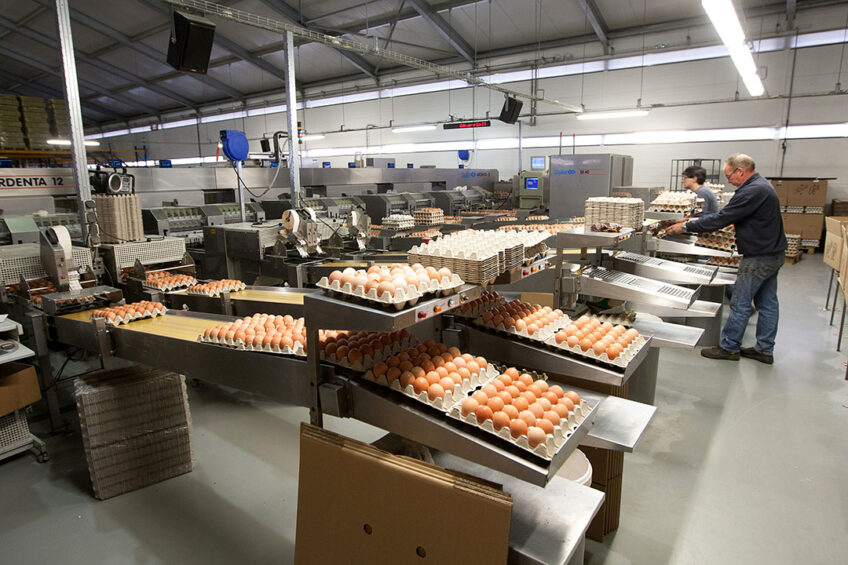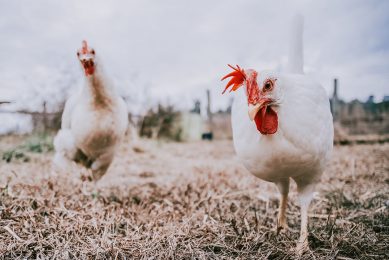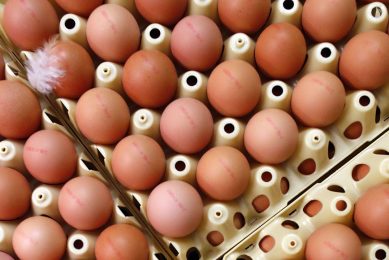Remarkable dynamics of the global egg industry

The growth of output from the global egg industry in the last 50 years is more than impressive. Poultry World is honoured to publish an expert analysis on the development of the industry and document the remarkable growth of global egg production and trade of this commodity.
Between 1970 and 2020, global egg production increased from 19.5 million tonnes to 87.1 million (up 347%). Table 1 shows that from 1990 on, production volumes grew significantly faster than in the previous 2 decades. Between 2010 and 2020 alone, volumes grew by almost 23 million tonnes. A closer look at the development at continent level reveals the extraordinary role which Asia played in this booming development.
To the absolute growth of 67.6 million tonnes in the decades under review, Asia contributed 73.3%, followed by Central and South America with 13%. All other continents were far behind. The relative growth in Africa (4.5%) was even higher than in Europe and North America. Until 1988, egg production volume in Europe was higher than in Asia, but from then on extraordinary growth began in several Asian countries, as is documented later in this article.
Considerable changes at the country level
Over the past 50 years, the composition and ranking of the leading egg-producing countries changed considerably. Until 1985, the USA was in first place before it was replaced by China, which in the following years remained the unchallenged number one.
A closer look at the dynamics reveals some remarkable changes. Between 1990 and 2020, India climbed from sixth to second place and surpassed the USA. Indonesia, which was not among the 10 leading countries until 2000, climbed to fourth place and has increased its egg production by 4.5 million tonnes since then.
While in 1970, 6 European countries (Germany, France, the UK, Italy, Spain and Poland) were in the top group, in 2020, only France was left, taking tenth place. A remarkable dynamic development also showed growth of production in Brazil, Mexico and since 2010, Turkey. In contrast, Japan fell from the third to the seventh place and production in the former USSR, number 2 until 1990, fell sharply after the economic collapse in Russia. In 2020, the Russian Federation only ranked number 8.
A first interim balance can be summarised as follows. Global egg production more than quadrupled between 1970 and 2020, reaching a volume of 87.1 million tonnes. Parallel to this remarkable increase, a drastic change in geography occurred. Europe and North America lost their leading positions to Asia and Central and South America, which in 2020 contributed almost 3-quarters of global production volume. During this dynamic development, the composition and ranking of the leading countries changed considerably.
While in 1970, the USA and the USSR were the leading egg-producing countries, China and India occupied the first 2 positions in 2020. In 1970, 6 European countries belonged to the top-10 group (not counting the USSR). In 2020, only 1 European country remained, i.e., France was in tenth place. This comparison graphically describes the drastic changes in the spatial pattern of global egg production.
Egg trade volume comparatively small
In contrast to poultry meat, the volume of traded eggs is comparatively small. In the decades under review, only between 1.8% (2000) and 2.8% (1980 and 2010) of production was exported. The reasons for this low trade volume are the fact that eggs cannot be frozen and have a relatively short shelf life. Most eggs are produced for domestic consumption. Nevertheless, exports (and imports) are of a considerable economic importance for several countries. The following analysis documents the trade patterns at the continent and country level.
Table 2 provides an overview of the development of egg exports and imports and the trade balance at the continent level. It is clear that Europe dominated egg trade over the past 50 years. It was not until 2000 that Asia’s egg exports were higher. In all other continents, egg trade was only of minor importance. Europe showed a trade surplus over the whole period under review, as did North America since 1980. Africa and Central and South America had a negative trade balance in all decades, as did Asia (with the exception of 2010).
Considerable fluctuations in egg exports at the country level
Over the years there were considerable fluctuations in the composition and ranking of the top 10 exporting countries. The Netherlands have, after several years of competition with Belgium, been the leading egg exporting country since 1975. Belgium, number one until 1974, fell to the ninth position in 2020 and China fell from third to tenth.
Several countries only belonged to the top group for a short time, such as Denmark, Romania, Hungary, the UK, France, the USSR, Iran, Belarus and Syria. Other countries, such as the USA, Germany, Spain and Malaysia, were able to reach a stable position among the leading exporting countries.
In 1970, Poland played an important role as an egg exporting country as a member of COMECON (the Council for Mutual Economic Assistance), but could not maintain its position after the collapse of that system. It was not until 2010 that, after the remarkable development of the poultry industry as an EU member state, Poland became a leading egg exporter again. A similar development occurred in Turkey, which became the second most important egg exporting country in 2011 after years of extraordinary growth in its poultry industry.
The regional concentration of egg exports was even greater than egg production. In 1990, the 10 top-ranked countries contributed 89.2% to global export volumes. In 2010, the lowest value was reached (74.5%) before climbing to 78.5% in 2020. In 1990, the Netherlands contributed 50.9% to global egg exports. Then in 2020, the country´s share had declined to only 19.9% despite an increase in export volumes. The growing production in Turkey, Poland, the USA, Uzbekistan and Malaysia challenged the dominating role of the Netherlands.
Considerable fluctuations in egg imports at country level
The composition and ranking of the 10 leading countries in egg imports also fluctuated considerably with the exception of Germany. Worth noting are the changes in the ranking of several EU member states in the decades under review, such as France, the UK, the Netherlands and Italy. In 1970, France was in third place then fell to tenth in 1980, climbed to fifth and fourth in 1990 and 2000, respectively, before it again fell to ninth in 2020. There were similar dynamics in the UK. Belgium and Singapore began to import eggs in 1990, and in 2020 they ranked as fourth and fifth, respectively.
Of particular interest is the Netherlands. While they were eighth in 1970, they became the second-largest egg importing country in 2020. This is due to the fact that Dutch investors bought and/or built large egg farms in eastern Germany after the reunification of the country. They then transferred the eggs produced on these farms to the Netherlands either for export or to further process them. This transfer appears as imports for the Netherlands and exports for Germany in the FAO database. Until 1980, the USSR imported eggs from other COMECON countries, but stopped imports after the collapse of its political and economic system.
In 2020, the Russian Federation began to import eggs again to supply the population with animal protein due to the dramatic decline in pork production which resulted from outbreaks of African Swine Fever. Because of the Gulf War, Iraq’s egg industry was severely hit so that imports became necessary to meet domestic demand. From 2010 on, the country ranked second among the top 10 importing countries. As egg production began to recover, imports decreased from 2020 onwards. In 2020, the United Arab Emirates and Saudi Arabia imported large amounts of eggs for domestic consumption and for further exports to other countries on the Arabian Peninsula.
The regional concentration in egg imports reached similar values to that of exports; it decreased, however, between 2010 and 2020 as a result of the fast growth of imports by Russia and western Asian countries. Between 1970 and 1990, the first 3 leading countries shared over 50% in global imports with a peak of 55.1% in 1980. In the following decades, the regional concentration was lower and in 2020, the 3 top countries only imported 38.3% of the eggs which were traded globally.
Worth noting is the changing share of Germany in global egg imports. Between 1970 and 1990, the country imported between 32% and 39.5% of the eggs which reached the global market. From then on, this share fluctuated between 28.7% in 2010 and only 17.7% in 2020. From 2010 to 2020, import volumes fell by 100,000 tonnes despite an increase in per capita consumption. This was possible because of the considerable growth of the poultry inventory by more than 10 million hens in that decade.
Summary and perspectives
The analysis here shows the remarkable increase in global egg production and drastic spatial shifts. Which were the decisive innovations and steering factors behind this success story? A first innovation was the use of hybridisation technology in the breeding of laying hens. It started in 1950 in the USA and was transferred to Europe in the late 1950s. Specialised breeder companies began to market hatching eggs and chicks worldwide.
A second innovation was the construction of cages with automatic feeding, water supply, egg collection and manure handling. This drastically reduced the required labour input and made much larger flocks possible. The efficient housing system spread in parallel with the hybrid hen.
A third innovation was the development of vaccines against Newcastle Disease (1954) and Marek´s Disease (1972). These treatments improved the health status of the laying hens and reduced mortality rates to less than 5%.
A very important steering factor was the development of a compound feed with special additives, which improved the nutrition of the hens. This also contributed to the health of the hens and increased the laying rate considerably. The combination of these factors made it possible to produce large amounts of eggs with a high nutritional value at a reasonable price for the growing global population.
It is worth noting that a similar trend in the organisation of egg production developed worldwide: vertically integrated companies. As no religious barriers prohibited the consumption of eggs, production and consumption grew and resulted in a spatial shift of the major production centers.
While in 1970 Europe and North America contributed almost 2-thirds of the global production volume, their share fell to 21.8% in 2020. In contrast, Asia and Central and South America contributed only 30.7% in 1970, but reached 74.1% in 2020, China and India together shared 42.0%. Of the 6 European countries which belonged to the top 10 group in 1970, only 1 remained in 2020. This graphically describes the drastic change in the global pattern of egg production.
Although the volume of egg trade only accounted for a share of less than 3% of global egg production, it reached a considerable economic importance for the leading exporting and importing countries. Europe dominated the egg trade over the period which is analysed in this paper and it was not before 1990 and 2020, respectively, that Asia achieved a higher share of exports and imports. Europe was also the only continent with a positive trade balance over the past 50 years. North America showed a trade surplus from 1980 onwards and Asia only in recent years.
At the turn of the century, new challenges began to confront the egg industry. One is the animal welfare discussion, which in the EU already led to the prohibition of conventional battery cages from 2012 and the introduction of new housing systems, such as enriched cages, floor and free-range systems. In the coming 2 decades this will also reduce the number of hens kept in conventional cages drastically as developments in the USA, Canada and New Zealand show.
A second challenge is the threat of the avian influenza virus, which has caused disastrous epidemics since 2015 and become endemic in many countries. The success of the vaccines against Newcastle and Marek’s diseases could show a way out of this existential threat.
Despite these challenges, egg production and the volume of egg trade will further increase because of a growing demand in several threshold and developing countries. The spatial pattern will remain stable. Europe and North America will lose their share in production but Europe will be able to maintain its leading position in egg trade. Although several companies and start-ups have been successful in the production and sale of plant-based egg substitutes, these will not reach double-digit volumes before 2030.
References available upon request.
 Beheer
Beheer











 WP Admin
WP Admin  Bewerk bericht
Bewerk bericht